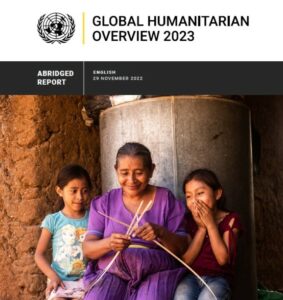339 million people, equivalent to one in 23 of the world’s population, will need humanitarian aid in 2023. That was the conclusion of the United Nations (UN) as it launched its Global Humanitarian Overview in December 2022. In this article, we discuss the UN’s report and how philanthropists can address growing humanitarian needs.

The war in Ukraine, a global food crisis and climate change are all major factors behind the 25% annual increase in the number of people that will need humanitarian relief in 2023. The Russian invasion of Ukraine has forced millions to flee their homes and destroyed basic infrastructure. The war has also created a wider food crisis. Food shortages are affecting countries such as Afghanistan, Somalia and Yemen, many of whom were already struggling as a consequence of internal conflict.
Climate-related disasters, including droughts and floods, are another cause of the global humanitarian crisis. The devastating flood in Pakistan is a prominent example of how climate change is causing death and destruction, although there are many others. Of the 15 countries most vulnerable to climate change, 12 are in receipt of international humanitarian aid.
Funding for humanitarian needs is stretched. Although funding for international aid has risen in each of the last ten years, it is not keeping pace with the rapid rise in humanitarian needs and the costs of addressing them. Whilst Western governments continue to fund the bulk of the international aid system, their budgets are under pressure. In the UK, for example, the government has cut the amount available to spend on international development from 0.7% to 0.5% of Gross National Income. The UN and its partners have the resources to reach 230 million of those in need in 2023, but this leaves a significant shortfall.
The UN has said that at least $50bn is required for the additional 109 million people in need of humanitarian assistance and hopes that other organisations and donors will help cover these costs. The UN recognises that private donors were very generous in 2022, but that the needs have grown.
For those wanting to contribute to meeting immediate humanitarian needs, international charities such as Médecins Sans Frontières (Doctors Without Borders) and the International Rescue Committee offer effective ways of giving.
Longer-term, there is clearly a requirement to prevent humanitarian needs arising in the first place. Since conflict is a source of much poverty, world leaders must do more to prevent war by upholding the international laws they have agreed to. They also need to get better at peacebuilding.
Addressing climate change is another moral imperative. The effects of climate change disproportionately affect the world’s poorest, even though they are least to blame for global carbon emissions. Unless we collectively tackle climate change, humanitarian crises will get progressively worse. Historically, a relatively small proportion of charitable giving has gone towards addressing climate change. That said, more money is now flowing into a wide range of climate-related charitable activities including climate activism, protecting rainforests, restoring nature to absorb more carbon, improving farming, promoting veganism, reducing consumption, investment in renewable energy and promoting sustainable transport. There are now plenty of opportunities for philanthropists to make a contribution in this area.

There is also a need to build stronger and more resilient communities so that people can cope and face the future on their own terms. Despite progress on reducing poverty over the last 30 years, it is a sad fact that 1 in 10 people are still struggling to survive on less than $2 a day. When disaster hits, these people inevitably lack the resources to respond.
In delivering development aid, there is growing recognition that local people are usually best placed to understand their needs and develop their own solutions. One increasingly credible approach to addressing poverty, which trusts local people to decide what is best for them, is the provision of direct cash payments. Give Directly is at the forefront of this approach, which involves sending money direct to some of the world’s poorest people. The charity uses independent research to document the impact of the cash transfers on recipients and their local economy, and the results suggest that the approach is effective. It is a remarkably simple idea, but one that seems to work. Give Directly is currently active in just a handful of countries and so there is enormous potential to scale up their work and reach more people in poverty. In this regard, there is plenty of scope for philanthropy to make a difference here.
If you are a major donor with £250,000 or more to give to charity and are interested in exploring how your philanthropy can make a major difference to the world’s poor, The Charity Service can assist. We offer an effective and tax-efficient giving vehicle in the form of a Donor Advised Fund, and a philanthropy advice service to help you get the most out of your giving. If you would like to find out more, please book an appointment with one of our advisors.

